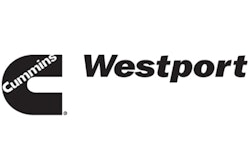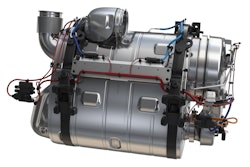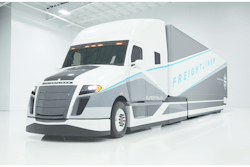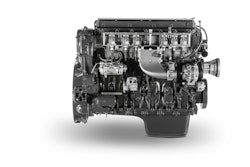Westport Fuel Systems Inc. has reported financial results for the quarter ended June 30, 2016. The quarter and year-to-date results for the period ended June 30, 2016 include one month of the former Fuel Systems Solutions Inc. (Fuel Systems) results following completion of the merger that closed on June 1, 2016. All figures are in U.S. dollars unless otherwise stated.
The merger between Fuel Systems and Westport Innovations Inc. (Westport) closed in the second quarter of 2016. The combined entity now known as Westport Fuel Systems has operations around the globe with a talented team, serving customers in over 70 countries and offering a variety of leading brands in the transportation and industrial applications space. Nancy Gougarty was appointed as Chief Executive Officer (CEO) on July 22, 2016 to lead this global alternative fuel company.
"I am confident that we can transform the company into a profitable and sustainable organization," says Nancy Gougarty, CEO of Westport Fuel Systems. "Our focus is on developing and implementing a strategy that will drive greater customer and shareholder value, even during a period of modest market demand prior to more wide-spread adoption of alternative fuels in the global transportation industry. We need to move quickly and decisively, while ensuring we do this right and consider a range of alternatives, while exercising capital discipline."
As part of the transformation, the new leadership team has initiated a review of the company's entire portfolio of products and technologies. "Work is well underway to integrate the organization, capture synergies, and drive efficiencies," says Gougarty. "Our initial assessment of the merged portfolio has identified 15 distinct operating lines and multiple technology groups. We are conducting a thorough evaluation, identifying our core strengths and capabilities, and assessing current financial performance and competitive market positioning. We are already taking actions that will lead to a much more focused portfolio with capital investment and resources targeted to the businesses and technologies that will drive long-term profitability. I expect that this strategic evaluation will be largely completed by year-end, setting us up for a stronger 2017 and beyond."
KEY DELIVERABLES IN 2016
- Merger & Integration: The merger was completed on June 1, 2016 and the new leadership team continues to focus on implementing integration of the newly combined entities.
- Rationalize Portfolio: The leadership team has initiated a full portfolio evaluation and expects to complete non-core asset sales, and rationalize operations and corporate costs as appropriate. There will be a thorough evaluation, identifying core strengths and capabilities, and assessing financial performance and competitive market positioning.
- Drive Efficiencies and Intensify Capital Discipline: Organizational restructuring and cost reduction activities are underway to strengthen operational effectiveness globally. The company continues to improve efficiency and generate cash flow savings from global operations through better utilization of collective talents and assets while eliminating redundancies.
- Strengthen Balance Sheet: The merger strengthened the balance sheet and the company is continuing to take steps to further strengthen its financial position.
- Advance Commercialization of Westport HPDI 2.0: Westport Fuel Systems' major system development program continues to be on schedule and on budget for commercial release to original equipment manufacturer (OEM) customers in 2017. The programs are well into the testing and validation phase, with the focus being on engine performance and durability testing, and the liquefied natural gas fuel tank systems. Production design intent components were delivered to OEM customers for vehicle integration in Q2 2016. As previously disclosed, the company is investing in and developing the production facilities for the latest generation of Westport HPDI 2.0 injectors within Delphi's injector manufacturing plants.
In an interview published in the July 2016 issue of lastauto omnibus magazine (a leading German transportation magazine), AVL's representative stated that the OEMs will not be able to avoid implementing HPDI technology in order to fulfill greenhouse gas (GHG) limit values. When using renewable natural gas, GHG emissions could be reduced by more than 80% compared to diesel. AVL believes this is a significant reason for vehicle manufacturers' high interest in HPDI technology. AVL List GmbH is one of the world's leading powertrain engineering firms, with over 8,000 employees worldwide.
CASH AND PRIORITIZATION OF INVESTMENTS
"One of our key near-term financial goals for the company remains achieving positive Adjusted EBITDA on a sustained basis," states Ashoka Achuthan, Chief Financial Officer of Westport Fuel Systems. "The portfolio decisions we make in the coming months will support this goal and we are already making significant strides. Our cash position has improved with the merger and we continue to look to strengthen it as we move forward."
- As of June 30, 2016, the company's cash, cash equivalents, and short-term investments totaled $71.2 million. Cash used in operations, excluding changes in working capital, plus dividends received from joint ventures for the second quarter of 2016 was $17.5 million, a sequential increase of 59.0% or $6.5 million from the quarter ended March 31, 2016. The increase is primarily due to an increase in merger, integration and financing costs of $3.1 million, a reduction of dividends received from joint ventures for $2.1 million, and $1.2 million in restructuring costs.
- On June 1, 2016, the company received $17.5 million in cash from affiliates of Cartesian Capital Group (Cartesian) in accordance with the amended investment agreement, initially announced on January 11, 2016 and amended on March 7, 2016. Under the terms of the agreement, the investment is received in exchange for 9.0% convertible unsecured notes due June 1, 2021 which are convertible into common shares of Westport Fuel Systems Inc. in whole or in part, at Cartesian's option, at any time following the 12 month anniversary of the closing at a conversion price of $2.17 per share.
- Subsequent to June 30, the company completed the sale of assets in Plymouth, MI, for a total value of over $12.0 million, as well as assets in Union City, IN, while relocating operations to Dallas, TX, facility. In addition, the company also plans to complete the consolidation of corporate functions no later than the end of Q3 2016. These actions are expected to reduce annual operating expenses by over $9.0 million.
- The leadership team has taken additional measures to focus on post-merger integration synergies, EBITDA and working capital improvement including inventory management. To this end, the company has selectively engaged consulting firms including AlixPartners to support achievement of synergies and EBITDA improvement also through materials procurement, working capital and supply chain management.
SEGMENT REPORTING
Westport Fuel Systems has updated its segment reporting to reflect how the current business operates. The principal focus and responsibilities of the new reporting segments are summarized below:
- Automotive Business Unit: consists of the company's passenger and commercial transportation products, including both OEM and aftermarket products.
- Industrial Business Unit: consists of the company's industrial mobile and stationary equipment solutions as well as auxiliary power unit (APU) products.
- Corporate and Technology Investments Business Unit: responsible for investments in research and development programs with OEMs, corporate oversight and general administrative functions.
- Cummins Westport Inc. Joint Venture: a 50:50 joint venture with Cummins Inc., the leading supplier of natural gas engines to the North American medium- and heavy-duty truck and transit bus industries.
In the second quarter of 2016, the company sold a portion of its economic interest in Weichai Westport Inc. (WWI) to Cartesian for an upfront payment of $6.3 million plus a potential future payment based on Cartesian's return on investment. As the company no longer has significant influence in the joint venture and no longer equity accounts for this investment, the company does not consider WWI a business segment.
Q2 2016 FINANCIAL HIGHLIGHTS
- Consolidated revenues for the quarter ended June 30, 2016 were $44.4 million compared with $27.8 million for the same period last year mainly due to the addition of Fuel Systems' revenues of $20.8 million for the month of June. Westport revenue for the quarter ended June 30, 2016 decreased by $4.2 million or 15.2%, mainly due to a large service contract completed in Q2 2015.
- Consolidated gross margin for the quarter ended June 30, 2016 was $10.0 million or 22.5% of revenue, compared with $9.3 million or 33.4% of revenue for the same period last year. The decrease in Westport gross margin percentage was mainly due to a large service contract completed in Q2 2015. Excluding this, Westport gross margin would have been 26.3% in Q2 2015.
- Consolidated operating expenses were $34.2 million for the quarter ended June 30, 2016, an increase of $8.4 million from $25.8 million in the same period last year primarily driven the addition of Fuel Systems' expenses of $5.6 million. Westport operating expenses increased by $2.8 million or 10.9% year-over-year, primarily due to additional one-time costs related to the merger with Fuel Systems and the Cartesian financing.
- Net income for the quarter ended June 30, 2016 was $3.7 million, or $0.05 per share, primarily due to a one-time non-cash gain on the bargain purchase transaction related to the merger of $42.9 million. Excluding the bargain purchase transaction and Fuel Systems' June 2016 net loss of $0.1 million, Westport Fuel Systems net loss for the quarter ended June 30, 2016 would have been $39.1 million.
CUMMINS WESTPORT INC. HIGHLIGHTS
- Revenue was $73.6 million on 2,061 units for the quarter ended June 30, 2016, a decrease of 20.9% in revenue over the same period last year primarily due to macroeconomic conditions including sustained low oil prices and weakened truck industry volumes. However, this was offset by growth in the transit market with year-to-date shipments up 45% year-over-year.
- Gross margin during the quarter ended June 30, 2016 decreased by $3.7 million from $24.7 million to $21.0 million when compared to the same quarter last year. The margin decrease was primarily as a result of lower unit sales. The increase in gross margin percentage year-over-year for the quarter ended June 30, 2016 was primarily due to due to year-over-year favorable warranty adjustment.
- CWI operating income attributable to Westport Fuel Systems for the quarter ended June 30, 2016 was $1.5 million compared with $3.4 million for the same period last year. This is primarily due to a decrease in unit sales and higher engineering expense mainly related to new products and compliance costs for upcoming regulations.
- The Cummins Westport ISB6.7 G natural gas engine was launched in Q2, with 200 hp and 220 hp rating for the Type C school bus market. The ISB6.7 G meets U.S. Environmental Protection Agency (EPA) and California Air Resources Board (ARB) 2016 emissions regulations; ARB's optional low oxides of nitrogen (NOx) standard of 0.1 g/bhp-hr; and 2017 EPA GHG requirements a year ahead of schedule.
- According to Fleets & Fuels article published on July 5, 2016, a recent study commissioned by LA Metro found that the Cummins Westport ISL G Near Zero NOx natural gas engine, when powered by renewable natural gas (RNG), will allow California to meet its goal of zero-emission transit buses more quickly and for less money than it will with battery electric or hydrogen fuel cell buses. Fleet costs would rise by just 1% with low NOx+RNG, as compared to 8- 14% for all-electric buses or 9-13%, according to a presentation by Dana Lowell of M.J. Bradley & Associates and Julia Lester of Ramboll/Environ for LA Metro.

















